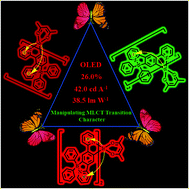Manipulating MLCT transition character with ppy-type four-coordinate organoboron skeleton for highly efficient long-wavelength Ir-based phosphors in organic light-emitting diodes†
Abstract
Inspired by the intriguing optoelectronic characteristics of the 2-phenylpyridine-type (ppy-type) four-coordinate organoboron skeleton, we envisage a molecular design strategy by manipulating the MLCT transition character to develop high-performance long-wavelength Ir-based phosphors with a ppy-type four-coordinate organoboron skeleton for organic light-emitting diodes (OLEDs). Three ppy-type cyclometalated Ir(III) complexes are successfully prepared. IrOBN and IrPBN exhibit the expected long-wavelength phosphorescent emission at 620 and 604 nm, respectively, due to the electron-accepting ability of the pyridine coordinated with the boron atom (pyd(B)) in extending the π-conjugated length for the LUMO, thus leading to stabilization of the LUMO. Interestingly, IrMBN shows a green phosphorescence at 514 nm. The more electron-deficient pyd(B) in IrMBN leads to a reorganized and localized LUMO distribution pattern mainly on pyd(B) rather than the pyridine coordinated with the Ir atom (pyd(Ir)), shortening the π-conjugation length for the LUMO, hence resulting in an elevated LUMO. Benefiting from the high rigidity of the ppy-type four-coordinate organoboron skeleton, these three ppy-type cyclometalated Ir(III) complexes show high PLQY (ca. 0.6–1). Beneficially, we can achieve impressive electroluminescence (EL) performance based on IrPBN with the highest efficiencies of a maximum external quantum efficiency (ηext) of 26.0%, a maximum current efficiency (ηL) of 42.0 cd A−1, and a maximum power efficiency (ηP) of 38.5 lm W−1, respectively. All these excellent results convincingly demonstrate the effectiveness of our molecular design strategy and the great potential of the ppy-type four-coordinate organoboron skeleton in developing high-performance Ir-based phosphors.



 Please wait while we load your content...
Please wait while we load your content...